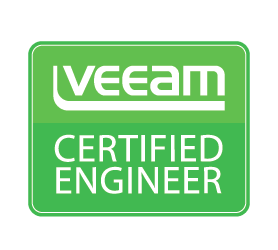The Veeam Certified Engineer (VMCE) V9.5 Study Guide.
Below is an incomplete list of study material I used for my VMCE Study Guide. This guide may not be up to date on the latest version of Veeam. (Updated 1/17/2019)
After going through the test and passing I wanted to share my experience for others out there to gauge what their experience will be. The test covered 11 sections:
- Overview of Veeam Products
- Deployment
- Initial Configuration
- Protect
- Verification
- Entire VM Recovery
- Objects Recovery
- Advanced Data Protection
- Veeam ONE Features and Functionality
- Product Editions
- Troubleshooting
VMCE Study Guide Overview:
First off, the test was 50 questions and you needed a 70% minimum to pass. I got 70 minutes to take the exam. Overall, I am not a good test taker. I needed the 70 minutes to look over my answers again and think through some questions that I flagged.
Before the test I used various resources to study and prep. Aside from the book that Veeam provides for the course, this guide here got me started with practice tests. Similarly, I found the test from rhyshammond.com the most helpful because it gave the answers to questions and even had some references on answers you got wrong with links to documentation. Very well done!
I work with Veeam every day since my work uses / offers Veeam as a cloud services provider. Even with my daily exposure to Veeam I needed to study to learn about the offerings I don’t use on a daily basis. Example: Hyper-V vs. VMware configurations, different backup methods, vendor storage directly compatible with Veeam, vendor monitoring that integrates with Veeam and so on.
Finally, I would say don’t underestimate the exam. Study well and give yourself time to learn the parts of Veeam that you don’t work with all the time. I hope the rest of my referenced material helps push you towards your certification!
(Updated 1/17/2019) List of supported storage compatible with Veeam Backup, reference:
- Cisco HyperFlex
- EMC (Dell)
- Dell EMC VNX
- Dell EMC VNX2
- EMC VNXe
- Unity
- Hewlett Packard Enterprise (HPE)
- HPE 3PAR StoreServ
- HPE StoreVirtual
- StoreVirtual VSA
- Nimble Storage
- Huawei OceanStor
- INFINIDAT InfiniBox
- Lenovo
- V-Series
- DM-Series
- NetApp
- FAS
- AFF Series
- IBM
- Spectrum Virtualize
- Storwize Family
- SAN volume controller
- Pure Storage FlashArray
Things to know:
First of all, see my list of Veeam extensions here:
Second, in order to use the predefined tests (Heartbeat, Ping, Application) for a VM you must have VMware tools or Hyper-V integration services installed on the VM. Likewise, you may also run custom scripts.
(Updated link 1/17/2019) Veeam explorers datasheet here:
Additionally, if you plan on using ‘extreme compression’ Veeam recommends using a proxy that has at least 6 modern CPU cores.
Another item is new compression settings are applied at the next run of a job. New deduplication settings are applied after a new active full backup is created.
Note that WAN accelerators must be installed on 64 bit Windows machines with a recommended minimum 8GB of RAM.
SureBackup recovery verification configurations: Basic (one network) and Advanced (two or more networks) single host virtual lab. This can work on VMware or Hyper-V.
Also, SureReplica recovery verification configurations: Single host basic (one network) and advanced (two or more networks) virtual lab. Also advanced (one or more networks, must reside in one datacenter) multi-host virtual lab. (SureReplica is only available with VMware)
Finally, Veeam supports these de-duplicating storage appliances: EMC Data Domain, ExaGrid, HPE StoreOnce. (This is old information as of 2017, keep in mind Veeam supports many storage appliances now, 2019, and that Veeam has a ‘Dedupe-friendly’ option now for storage appliances with dedupe, reference here).
Memorize these:
The five benefits of Veeam are:
- High-Speed Recovery
- Data Loss Avoidance
- Verified Recoverability
- Leveraged Data
- Complete Visibility
Additionally, the Veeam Support Response times (yes, this may be on the test).
| Severity | Production Support | Basic Support |
| 1 | 1 hour | 2 hours |
| 2 | 3 hours | 8 business hours |
| 3 | 6 hours | 12 business hours |
| 4 | 8 hours | 24 business hours |
Enter your address to subscribe to this blog and receive notifications of new posts!

